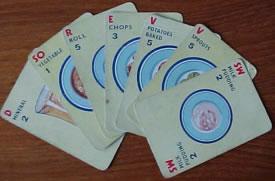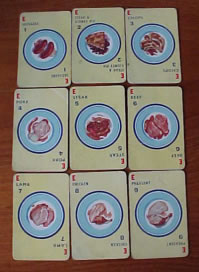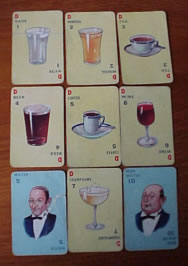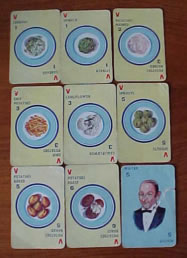- Home
- Applied Ability Awards
The GBK CookbookThe British Food TrustOther
After over 10 years of providing this website as an entirely free service the Trust now hopes that small donations from our viewers will allow the site to continue beyond 2013. |
Cards on the Tableby Marion WatsonI have in my possession a card game that was on the market just after the Second World War. It is called ‘Menuette’ and the cards feature various dishes – starters, fish, meat, vegetables, sweets and drinks worth varying numbers of points. The object of the game is to collect a complete meal with the highest possible score. But the interest in looking back after nearly fifty years is not only what was thought to be desirable in those days (and they must have seemed very attractive in those austerity–stricken times) but also what were the most costly items.
The most down-market soup was vegetable for one point whilst the top was chicken and turtle worth eight points. Does anyone eat turtle soup these days? The relative values of fish do not seem to have changed much. Bottom is cod for two points and top sole for ten with halibut just below at eight. When it comes to meat then there has been a change about. Top of the range is pheasant with nine, that has not changed much but next comes chicken at eight with lamb seven, beef six, steak five, pork four, chops three, steak and kidney pie two and sausages one. Chicken was a luxury eaten mainly at Christmas or on special occasions whilst beef was much more everyday, now the reverse is true. Steak and chops, those expensive, easily-prepared meats didn’t seem to be too highly rated. Possibly because fewer women went out to work preparation time was of less importance than it is today. We have grown accustomed to a wide choice of vegetables in the shops all year round. What was available in 1945? Spinach only got a score of one; it seems to be more highly rated today. And what puddings were in fashion then? Top of the bill is strawberries and cream, rated eight, peach melba six, and fruit salad five. Then comes plum pudding four with prunes and custard worth the same. Jam roll and fruit tart both get three whilst milk pudding comes lowest with two. Even if we bother with a sweet at all today we are not likely to eat some of those on offer. The lower values seem like fairly recent school dinners although the top ones are probably as popular now as they were then. An alternative to the sweets is cheese and biscuits at four. Bread rolls are worth five, which seems quite a lot but bread was rationed during the war and if required in a restaurant had to be substituted for one course of a three-course meal. Finally the drinks; of course champagne tops the list at seven with wine six. Coffee is worth five and beer four, which would surely be the other way round now. Tea gets three, mineral two and water one. With so many ‘designer’ waters on the market today they would surely rate more highly than that. Lastly there is a rather sinister looking waiter and waitress who looks like a Lyons Cornerhouse ‘Nippy’, both valued at five.
Foreign travel and television have had their effect on food choice. Personalities like Graham Kerr tempted people to make something like a pizza that they would never have tried otherwise. Convenience and store-cupboard foods provide a never-ending stream of innovations. Only twenty years ago pasta was limited to little more than spaghetti but now the supermarket shelves groan under an almost limitless variety of colours, shapes and flavours. Likewise the range of pulses and vegetarian foods has increased beyond all recognition. Instant potato, which was considered rather smart when it arrived in the 1960s, has now been overtaken by frozen noisettes, croquettes and waffles. Pine nuts have been all the rage, as has passata and artichoke hearts. Now sun-dried tomatoes seem to be the in thing. Care for the environment has had its effect too. Tinned salmon has given way to line-caught tuna. Many people are eating less meat or eat more vegetarian meals.
Sociologists tell us that family meals are becoming a thing of the past. ‘Grazing’ or eating on the run is the norm for many people now. Yet eating out and entertaining at home is as popular as ever although it is now perfectly acceptable to admit it is from Marks & Spencer! Perhaps the trend might be towards more high quality, ready-prepared meals. But given a few years our cookery books will look as old-fashioned as Mrs. Beeton’s does now and what is on our plate will be very different from the pictures on those playing cards. |
||





 Top of page
Top of page
 Previous page
Previous page